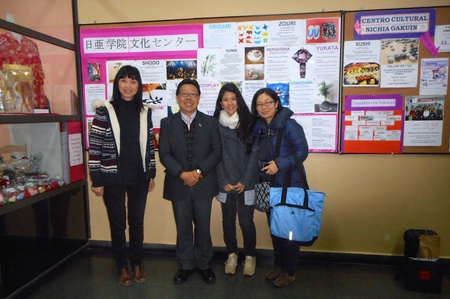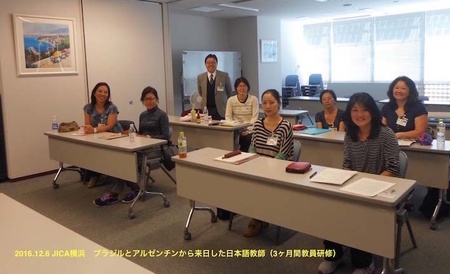In my previous column , I pointed out that there are 4 million people studying Japanese in the world, but how many students are there in the Japanese community overseas? According to a 2012 report by the Japan Foundation, there are 443 Japanese language education institutions in South America with 1,652 instructors teaching 32,968 students. This is less than 1% of the world's learners. The number of Japanese students in South America is even smaller, and it can be estimated to be half or less of the total in South America.
There are about 1.6 million Japanese descendants in Latin America, but the generational change has progressed considerably, and interest in the Japanese language is not as high as it used to be. Even if they attend Japanese language classes, most only attend once or twice a week, and there are very few Japanese descendants who study Japanese continuously from elementary school and at a junior high school level.
However, in urban areas with large concentrations of Japanese immigrants and Japanese descendants in Paraguay and Bolivia, community-run Japanese language schools have been established. Many students in these areas study Japanese every day. There are also semi-bilingual Japanese-Spanish schools, such as Liceo in Mexico, Nichia Gakuin in Buenos Aires, and Aer School in Lima, but most of the students are local non-Japanese. This is the current trend.

I was born and raised in Escobar, a town on the outskirts of Buenos Aires. There were two Japanese settlements there, and there were many Japanese people living in the city and its suburbs, so I took Japanese language and kanji classes for about three hours a day, five days a week. The teachers were a married couple who lived there, and they cooperated not only with school events but also with the Japanese Association's newsletter and various community activities. Thanks to that, many second and third generation Argentinians were able to not only acquire basic Japanese language skills, but also form an identity as a Japanese Argentine, and develop a sense of social responsibility to Argentine society and feelings toward Japan. There are many people like me who were able to study in Japan relatively smoothly, and many who have worked for local Japanese companies or Japanese institutions. However, from around the mid-1980s, more and more Japanese Argentines began to place importance on English, which is more practical and advantageous for work than Japanese. I also attended an English cram school during my junior high and high school years. It was a reasonable choice when considering going to university and finding a job afterwards.
Although the time may differ, the importance of Japanese language education and its sustainability are being discussed in Japanese communities in every country. The reason is that the number of Japanese students is decreasing due to generational change, mixed parental race, differences in parents' educational philosophy and attitudes toward the Japanese language, and the emphasis on English in language learning, making it difficult to pay the maintenance costs of facilities and teachers. Students and their parents are demanding more "interesting content." For example, they are asking for learning materials with videos and illustrations rather than textbooks that only contain kanji.
Meanwhile, about 20 years ago, non-Japanese youth and adults who were interested in Japanese subcultures such as anime and manga started to take an interest in learning Japanese. Thanks to these non-Japanese students, Japanese language schools in some cities have seen a resurgence in their numbers and have been able to continue operating. These schools have had to teach Japanese in a different way than the traditional Japanese education that had been based on the premise of cultivating a Japanese identity. There was some confusion on the grounds, but now, not only are there students, but the number of non-Japanese and non-native Japanese speakers among the instructors is gradually increasing. Some of these students are dedicated non-Japanese who have taken private Japanese language teacher training courses in Japan1 .
Many of the Japanese language teachers in the Japanese community are Japanese or Japanese descendants who are related to immigrants, and many of them teach as a side job. They have also received training in Japan or South America through organizations such as JICA, and improved their skills. The Japan Foundation also provides various training opportunities to many Japanese language teachers who teach overseas.
Even in Japanese language schools run by Japanese communities, the number of non-Japanese students is now increasing, which ironically improves the financial situation of the facilities and seems to have led to improved treatment of teachers. Also, with many local people now participating in large events such as Bon Odori and bazaars, some Japanese organizations are using part of the income to pay teachers' salaries.
In any case, courses related to Japanese culture have become an essential element of Japanese language education in recent years. Japanese language classes that teach Japanese culture, such as how to read anime and manga, how to draw anime characters, how to make furoshiki, hairpins, flower arranging, how to sew and wear yukata, sushi and Japanese cuisine, are popular. In addition to local Japanese and non-Japanese instructors, JICA's Youth Cooperation Volunteers and Japanese youth and senior volunteers dispatched from Japan teach or instruct in these classes.

Although the needs and interests of students are diverse, young leaders of Japanese organizations are operating them on a broad scale in a business-like manner, so Japanese language classes and courses related to Japanese culture are always bustling. Good examples include the Japanese Association of Peru, the Nichia Gakuin Cultural Center and Centro Nikkei in Buenos Aires, and the Japan-Mexico Association in Mexico.
A big concern for Japan right now is what type and skills of teachers should be sent, for how long, and for what purpose. Because the requests are so diverse, it is difficult to respond to all of them. However, looking at the government's Cool Japan policy2 , Japanese language education and Japanese culture-related outreach projects match the strategic goals of overseas market development and overseas PR, which are what Japan needs most right now.
On the other hand, the side requesting the dispatch of Japanese language teachers should also have a better understanding of the current situation. They should seek out human resources that meet the local needs, and they themselves should be more proactive in utilizing the existing human resources and making further efforts to train instructors to the extent possible. Simply accepting teachers from Japan for a certain period of time will end up being a stopgap measure. In some cases, the executives of the Japanese organizations that request dispatches from Japan do not properly grasp the needs and characteristics of the local area, and the voices of the local area are not reflected, so even if excellent teachers are dispatched, the results are poor and the end result is unpleasant. Even within the Japanese community, there are cases where constructive and realistic exchange of opinions about Japanese language education is insufficient due to opaque management methods and poor communication. First of all, it would be more effective to repair these parts and examine what kind of Japanese language teachers or Japanese culture instructors are needed to meet local needs, what purpose they should pursue, and how they will be given back to the local community before requesting dispatches from Japan.
Notes:
1. Interestingly, there is no national qualification for Japanese language teachers in Japan. You can become a Japanese language instructor if you major in Japanese at a graduate school, take more than 420 hours of Japanese language teacher training courses, and pass the Japanese Language Teaching Competency Examination. There are similar requirements when teaching Japanese at overseas universities, but private language schools and private schools in Japanese communities do not have such requirements, and do not ask for such knowledge. Some vocational schools offer Japanese language teacher training courses for foreigners (for example, Ueno Law and Business College ).
2. Ministry of Economy, Trade and Industry " Cool Japan Creative Industry "
Cool Japan Fund (Overseas Demand Development Fund Inc.) " Investment Schemes and Related Regulations "
© 2017 Alberto J. Matsumoto






